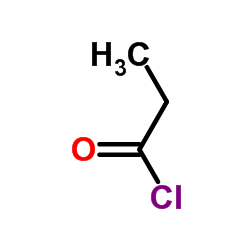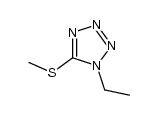69048-98-2
| Name | 1-ethyl-2H-tetrazol-5-one |
|---|---|
| Synonyms |
EINECS 273-844-2
1-ETHYLTETRAZOLINONE 1-ethyl-5(4H)-tetrazolinone 1-ethyl-1,4-dihydro-5H-tetrazol-5-one 1-ethyl-1,4-dihydrotetrazol-5-one 1-Ethyl-1,2-dihydro-5H-tetrazol-5-one 1-ethyl-4,5-dihydro-1H-tetrazol-5-one 1-ethyl-1H-tetrazol-5(4H)-one 1-Ethyl-1H-tetrazol-5-ol |
| Density | 1.55g/cm3 |
|---|---|
| Boiling Point | 120.7ºC at 760 mmHg |
| Molecular Formula | C3H6N4O |
| Molecular Weight | 114.10600 |
| Flash Point | 26.8ºC |
| Exact Mass | 114.05400 |
| PSA | 63.57000 |
| Index of Refraction | 1.676 |
Synonym: Section 2 - COMPOSITION, INFORMATION ON INGREDIENTS
Risk Phrases: 22 Section 3 - HAZARDS IDENTIFICATION EMERGENCY OVERVIEW
Harmful if swallowed.The toxicological properties of this material have not been fully investigated. Potential Health Effects Eye: May cause eye irritation. The toxicological properties of this material have not been fully investigated. Skin: May cause skin irritation. The toxicological properties of this material have not been fully investigated. Ingestion: May cause gastrointestinal irritation with nausea, vomiting and diarrhea. The toxicological properties of this substance have not been fully investigated. Inhalation: May cause respiratory tract irritation. The toxicological properties of this substance have not been fully investigated. Chronic: No information found. Section 4 - FIRST AID MEASURES Eyes: Flush eyes with plenty of water for at least 15 minutes, occasionally lifting the upper and lower eyelids. Get medical aid immediately. Skin: Get medical aid. Flush skin with plenty of water for at least 15 minutes while removing contaminated clothing and shoes. Wash clothing before reuse. Ingestion: If victim is conscious and alert, give 2-4 cupfuls of milk or water. Never give anything by mouth to an unconscious person. Get medical aid immediately. Inhalation: Remove from exposure and move to fresh air immediately. If not breathing, give artificial respiration. If breathing is difficult, give oxygen. Get medical aid. Notes to Physician: Section 5 - FIRE FIGHTING MEASURES General Information: As in any fire, wear a self-contained breathing apparatus in pressure-demand, MSHA/NIOSH (approved or equivalent), and full protective gear. During a fire, irritating and highly toxic gases may be generated by thermal decomposition or combustion. Extinguishing Media: Use agent most appropriate to extinguish fire. Use water spray, dry chemical, carbon dioxide, or appropriate foam. Section 6 - ACCIDENTAL RELEASE MEASURES General Information: Use proper personal protective equipment as indicated in Section 8. Spills/Leaks: Clean up spills immediately, observing precautions in the Protective Equipment section. Sweep up or absorb material, then place into a suitable clean, dry, closed container for disposal. Provide ventilation. Section 7 - HANDLING and STORAGE Handling: Wash thoroughly after handling. Use with adequate ventilation. Avoid contact with eyes, skin, and clothing. Keep container tightly closed. Avoid ingestion and inhalation. Storage: Keep container closed when not in use. Store in a cool, dry, well-ventilated area away from incompatible substances. Section 8 - EXPOSURE CONTROLS, PERSONAL PROTECTION Engineering Controls: Use adequate ventilation to keep airborne concentrations low. Exposure Limits CAS# 69048-98-2: Personal Protective Equipment Eyes: Wear appropriate protective eyeglasses or chemical safety goggles as described by OSHA's eye and face protection regulations in 29 CFR 1910.133 or European Standard EN166. Skin: Wear appropriate protective gloves to prevent skin exposure. Clothing: Wear appropriate protective clothing to prevent skin exposure. Respirators: Follow the OSHA respirator regulations found in 29 CFR 1910.134 or European Standard EN 149. Use a NIOSH/MSHA or European Standard EN 149 approved respirator if exposure limits are exceeded or if irritation or other symptoms are experienced. Section 9 - PHYSICAL AND CHEMICAL PROPERTIES Physical State: Crystals Color: white Odor: None reported. pH: Not available. Vapor Pressure: Not available. Viscosity: Not available. Boiling Point: Not available. Freezing/Melting Point: 78.30 - 79.80 deg C Autoignition Temperature: 300 deg C ( 572.00 deg F) Flash Point: Not available. Explosion Limits, lower: Not available. Explosion Limits, upper: Not available. Decomposition Temperature: Solubility in water: 500 g/l (20 c) Specific Gravity/Density: Molecular Formula: C3H6N4O Molecular Weight: 114.11 Section 10 - STABILITY AND REACTIVITY Chemical Stability: Stable under normal temperatures and pressures. Conditions to Avoid: Incompatible materials, strong oxidants. Incompatibilities with Other Materials: Oxidizing agents. Hazardous Decomposition Products: Nitrogen oxides, carbon monoxide, carbon dioxide. Hazardous Polymerization: Has not been reported. Section 11 - TOXICOLOGICAL INFORMATION RTECS#: CAS# 69048-98-2 unlisted. LD50/LC50: Not available. Carcinogenicity: 1-Ethyl-1,4-Dihydro-5H-Tetrazol-5-One - Not listed by ACGIH, IARC, or NTP. Section 12 - ECOLOGICAL INFORMATION Section 13 - DISPOSAL CONSIDERATIONS Dispose of in a manner consistent with federal, state, and local regulations. Section 14 - TRANSPORT INFORMATION IATA Not regulated as a hazardous material. IMO Not regulated as a hazardous material. RID/ADR Not regulated as a hazardous material. Section 15 - REGULATORY INFORMATION European/International Regulations European Labeling in Accordance with EC Directives Hazard Symbols: XN Risk Phrases: R 22 Harmful if swallowed. Safety Phrases: S 28A After contact with skin, wash immediately with plenty of water. S 28B After contact with skin, wash immediately with plenty of water and soap. S 37 Wear suitable gloves. S 38 In case of insufficient ventilation, wear suitable respiratory equipment. S 45 In case of accident or if you feel unwell, seek medical advice immediately (show the label where possible). WGK (Water Danger/Protection) CAS# 69048-98-2: No information available. Canada None of the chemicals in this product are listed on the DSL/NDSL list. CAS# 69048-98-2 is not listed on Canada's Ingredient Disclosure List. US FEDERAL TSCA CAS# 69048-98-2 is not listed on the TSCA inventory. It is for research and development use only. SECTION 16 - ADDITIONAL INFORMATION N/A |
|
~63% 
69048-98-2 |
| Literature: Janssens, Frans; Torremans, Joseph; Janssen, Paul A.J. Journal of Medicinal Chemistry, 1986 , vol. 29, # 11 p. 2290 - 2297 |
|
~% 
69048-98-2 |
| Literature: Journal of Medicinal Chemistry, , vol. 29, # 11 p. 2290 - 2297 |
|
~% 
69048-98-2 |
| Literature: Bioorganic and Medicinal Chemistry, , vol. 18, # 2 p. 839 - 848 |
| Precursor 3 | |
|---|---|
| DownStream 1 | |



